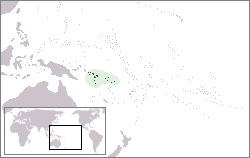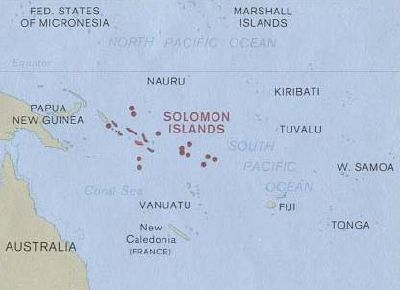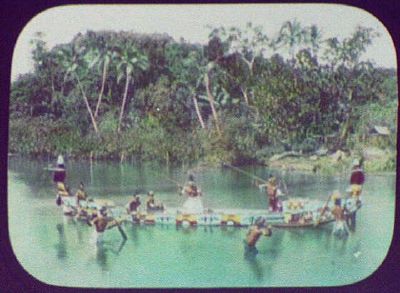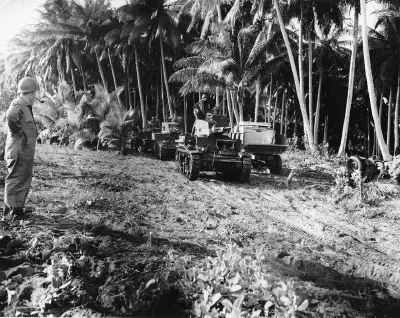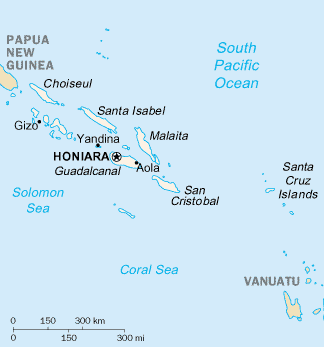Solomon Islands
Solomon Islands |
||||||
|---|---|---|---|---|---|---|
|
||||||
| Motto: "To Lead is to Serve" | ||||||
| Anthem: God Save Our Solomon Islands |
||||||
| Capital (and largest city) | Honiara 9°28′S 159°49′E | |||||
| Official languages | English | |||||
| Demonym | Solomon Islander | |||||
| Government | Unitary parliamentary constitutional monarchy | |||||
| - | Monarch | Charles III | ||||
| - | Governor-General | Sir David Vunagi | ||||
| - | Prime Minister | Jeremiah Manele | ||||
| Independence | ||||||
| - | from the United Kingdom | July 7, 1978 | ||||
| Area | ||||||
| - | Total | 28,400 km² (142nd) 10,965 sq mi |
||||
| - | Water (%) | 3.2% | ||||
| Population | ||||||
| - | 2024 estimate | 726,799[1] (167th) | ||||
| - | 2019 census | 721,956 | ||||
| - | Density | 24.2/km² (200th) 46.9/sq mi |
||||
| GDP (PPP) | 2024 estimate | |||||
| - | Total | |||||
| - | Per capita | |||||
| GDP (nominal) | 2024 estimate | |||||
| - | Total | |||||
| - | Per capita | |||||
| Gini (2013) | 37.1[3] | |||||
| Currency | Solomon Islands dollar (SBD) |
|||||
| Time zone | (UTC+11) | |||||
| Internet TLD | .sb | |||||
| Calling code | [[++677]] | |||||
Solomon Islands is a nation in Melanesia, east of Papua New Guinea, comprising more than 990 islands. Its capital is Honiara, located on the island of Guadalcanal.
The Solomon Islands have been inhabited by Melanesian people for at least 30,000 years. The United Kingdom established a protectorate over the Solomon Islands in the 1890s. Some of the bitterest fighting of World War II occurred on these islands. Self-government was achieved in 1976 and independence two years later. The country remains a Commonwealth Realm.
Since 1997, ethnic violence, government misconduct, and crime have undermined stability and civil society—to the extent that the nation has been categorized by some as a "failed state." In June 2003, an Australian-led multinational force, the Regional Assistance Mission to the Solomon Islands, arrived to restore peace and disarm ethnic militias.
Geography
The Solomon Islands group lies east of Papua New Guinea and consists of: Choiseul, the Shortland Islands, the New Georgia Islands, Santa Isabel Island, the Russell Islands, Nggela (the Florida Islands), Malaita, Guadalcanal, Sikaiana, Maramasike, Ulawa, Uki, Makira (San Cristobal), Santa Ana, Rennell and Bellona, the Santa Cruz Islands, and three remote, tiny outliers—Tikopia, Anuta, and Fataka. The distance between the westernmost and easternmost islands is about 930 miles (1,500 km). The Santa Cruz Islands, north of Vanuatu, (of which Tikopia is part) are more than 120 miles (200 km) from the other islands. Bougainville is geographically part of the Solomon Islands, but politically part of Papua New Guinea.
The islands together cover a landmass of 10,965 square miles (28,400 square kilometers), which is slightly smaller than the United States state of Maryland. The terrain comprises mostly rugged mountains with some low coral atolls. The highest point is Mount Popomanaseu at 7,651 feet (2,332 m). Forests and woodland cover 88 percent of the land area. Most of the islands are part of the Solomon Islands Rain Forests Ecoregion, which also includes the islands of Bougainville and Buka (part of Papua New Guinea). These forests have come under pressure from forestry activities. The Santa Cruz Islands are part of the Vanuatu Rain Forests Ecoregion, together with the neighboring archipelago of Vanuatu. Soil quality ranges from extremely rich volcanic to relatively infertile limestone. More than 230 varieties of orchids and other tropical flowers brighten the landscape. Natural resources include fish, forests, gold, bauxite, phosphates, lead, zinc, and nickel.
The climate is tropical, though temperatures are rarely extreme due to cooling winds blowing off the surrounding seas. Daytime temperatures are normally 77 °F to 90 °F (25 °C to 32 °C), falling about 37 °F to 41 °F (3 °C to 5 °C) at night. From April to October, the Southeast trade winds blow, gusting at times up to 30 knots or more. November to March is the wet season—the northwest monsoon—which is typically warmer and wetter. The annual rainfall is about 120 inches (305 cm). Cyclones arise in the Coral Sea and the area of the Solomon Islands, but they usually veer toward Vanuatu and New Caledonia or down the coast of Australia.
Natural hazards include typhoons, which are rarely destructive, frequent earth tremors, and volcanic activity. Environmental issues include deforestation, soil erosion, and the fact that much of the surrounding coral reefs are dead or dying.
The capital city of Honiara, situated on Guadalcanal, the largest island, has over thirty thousand inhabitants. The other principal towns are Gizo, Auki, and Kirakira.
History
The first human settlement of the Solomon Islands began at least thirty thousand years ago from New Guinea. The expansion of Austronesian-language speakers through the area, around 4000 B.C.E., brought new agricultural and maritime technology. Most languages spoken today in the Solomon Islands derive from this era, but some 30 languages of the pre-Austronesian settlers survive.
The first European to come upon the islands was Spanish explorer Pedro Sarmiento de Gamboa in 1568. Alvaro de Mendaña de Neira, who accompanied Sarmiento, found alluvial gold on Guadalcanal. Believing he had found the source of King Solomon's wealth, he named the islands "The Islands of Solomon." Spain lost its interest late in the sixteenth century, when one of Alvaro's ships was lost. Later, Dutch, French, and British navigators visited—their reception was often hostile. Missionaries began visiting in the mid-1800s. They made little progress at first, because "blackbirding"—the often brutal recruitment of laborers for the sugar plantations in Queensland and Fiji—led to reprisals and massacres. The evils of the labor trade prompted the United Kingdom to declare a protectorate over the southern Solomons in 1893. In 1898 and 1899, outlying islands were added to the protectorate; in 1900, the North Solomon Islands, was transferred from German to British administration. Missionaries settled then and converted most of the population to Christianity.
In the early twentieth century, several British and Australian firms began large-scale coconut planting. Economic growth was slow, however, and the islanders benefited little. When World War II broke out, planters and traders were evacuated to Australia, and most cultivation ceased. Some of the most intense fighting of World War II occurred in the Solomons. The most significant of the Allied Forces' operations against the Japanese Empire Forces was launched on August 14, 1942, led by the 1st Division of the U.S. Marines Corps with amphibious landings on the Florida Islands at Tulagi and Red Beach on Guadalcanal. The Battle of Guadalcanal became one of the most important battles fought in the Pacific theater.
The destruction caused by the fighting and the introduction of modern materials, machinery, and western cultural artifacts, transformed traditional island ways of life. Reconstruction was slow in the absence of war reparations. Pre-war plantations, formerly the mainstay of the economy, had been destroyed. Significantly, Solomon Islanders' experience as laborers with the Allies led some to appreciate the importance of economic organization and trade.
British colonial government returned after the end of World War II. The capital was moved from Tulagi to Honiara to use infrastructure left behind by the U.S. military. A native post-war political movement, "Maasina Ruru," defied government authority. There was much disorder until some of the leaders were jailed in late 1948. Throughout the 1950s, other indigenous dissident groups appeared and disappeared. In 1960 a legislative council superseded an advisory council of Solomon Islanders, and an executive council was created as the protectorate's policymaking body. In 1974, a new constitution established a parliamentary democracy and ministerial system of government. In mid-1975, the name Solomon Islands officially replaced that of British Solomon Islands Protectorate. On January 2, 1976, the Solomons became self-governing, and independence followed on July 7, 1978. The first post-independence government was elected in August 1980.
After the 1997 election of Bartholomew Ulufa'alu, ethnic rivalries marred the performance of the police and other government agencies. The capital of Honiara on Guadalcanal was increasingly populated by migrants from the island of Malaita. In June 2002, an insurrection mounted by Malaitan militants resulted in the brief detention of Ulufa’alu, who was forced to resign. Manasseh Sogavare, leader of the People's Progressive Party, was chosen prime minister by a loose coalition of parties. Guadalcanal militants retaliated and sought to drive Malaitan settlers from Guadalcanal, resulting in the closure of a large oil-palm estate and gold mine, both vital to exports. Elections in December 2001 brought in Sir Allan Kemakeza as prime minister and a coalition government.
Kemakeza attempted to address deteriorating law and order, but widespread extortion and ineffective police prompted a formal request for outside help. In July 2003, Australian and Pacific Island armed forces arrived under the auspices of the Australian-led Regional Assistance Mission to Solomon Islands (RAMSI). An international security contingent of 2,200 police and troops, led by Australia and New Zealand, and with representatives from about 20 other Pacific nations, began arriving the next month under Operation Helpem Fren. Consequently, some analysts describe the country as a failed state.
In April 2006, allegations that the newly elected Prime Minister Snyder Rini had used bribes from Chinese businessmen to buy the votes of members of Parliament led to rioting in Honiara. Resentment against the minority Chinese business community led to much of the city's Chinatown being destroyed. The People's Republic of China sent chartered aircraft to evacuate hundreds of Chinese. Further Australian and New Zealand troops were dispatched. Rini resigned and Manasseh Sogavare was elected prime minister.
Politics
The Solomon Islands are a constitutional monarchy and have a parliamentary system of government. King Charles III is the head of state. He is represented by the Governor-General who is chosen by the Parliament for a five-year term. There is a single-chamber parliament of 50 members, elected for four-year terms. Parliament may be dissolved by majority vote of its members before the completion of its term. Parliamentary representation is based on single-member constituencies. Suffrage is universal for citizens over age 18. The head of government is the prime minister, who is elected by parliament and chooses the cabinet. Each ministry is headed by a cabinet member, who is assisted by a permanent secretary, a career public servant. Solomon Islands governments are characterized by weak political parties and highly unstable parliamentary coalitions. They are subject to frequent votes of no confidence, and government leadership changes frequently as a result. Cabinet changes are common.
Land ownership is reserved for Solomon Islanders. The law provides that resident expatriates, such as the Chinese and Kiribati, may obtain citizenship through naturalization. Land generally is still held on a family or village basis and may be handed down from mother or father according to local custom. The islanders are reluctant to provide land for nontraditional economic undertakings, and this has resulted in continual disputes over land ownership.
For local government, the country is divided into ten administrative areas, of which nine are provinces administered by elected provincial assemblies, and the tenth is the town of Honiara, administered by the Honiara Town Council. There is no military. The police force of nearly five hundred includes a border protection element. The police also have responsibility for fire service, disaster relief, and maritime surveillance.
Politics in the Solomons are influenced by its diplomatic importance to the People's Republic of China and Republic of China (Taiwan). The Solomon Islands recognizes the Taiwan (ROC) as the sole legitimate government of all of China, giving Taiwan vital votes in the United Nations. Lucrative investments, political funding, and preferential loans from both China and Taiwan increasingly manipulate the political landscape. Relations with Papua New Guinea, strained because of an influx of refugees from the Bougainville rebellion and attacks on the northern islands of the Solomon Islands by elements pursuing Bougainvillean rebels, have been repaired. A peace accord on Bougainville confirmed in 1998, has removed the armed threat, and the two nations regularized border operations in a 2004 agreement.
Economy
Solomon Islands ranks as a lesser developed nation, and more than 75 percent of its labor force is engaged in subsistence farming and fishing. Most manufactured goods and petroleum products must be imported.
Until 1998, when world prices for tropical timber fell steeply, timber was Solomon Islands' main export product, and, in recent years, Solomon Islands forests were dangerously over exploited. Other important cash crops and exports include copra and palm oil. In 1998, Ross Mining of Australia began producing gold at Gold Ridge on Guadalcanal. Mineral exploration in other areas continued. However in the wake of the ethnic violence in June 2000, exports of palm oil and gold ceased while exports of timber fell. Negotiations are underway which may lead to the eventual reopening of the Gold Ridge mine and the major oil-palm plantation.
The islands are rich in undeveloped mineral resources such as lead, zinc, nickel, and gold. Exploitation of Solomon Islands' fisheries also offers prospects for export and domestic economic expansion. However, a Japanese joint venture, Solomon Taiyo Ltd., which operated the only fish cannery in the country, closed in mid-2000 as a result of the ethnic disturbances. Though the plant has reopened under local management, the export of tuna has not resumed.
Tourism, particularly diving, is an important service industry, although growth is hampered by lack of infrastructure and transportation limitations.
Export commodities include timber, fish, copra, palm oil, and cocoa. Export partners include China, South Korea, Thailand, Japan, and the Philippines. Import commodities include food, plant and equipment, manufactured goods, fuels, and chemicals. Import partners include Australia, Singapore, New Zealand, Fiji, and Papua New Guinea.
Demographics
The majority of the people on the Solomon Islands are ethnically Melanesian; Polynesian and Micronesian are the two other significant groups.
There are 74 languages in the Solomon islands, four of those extinct. On the central islands, Melanesian languages are spoken. Polynesian languages are spoken on the outliers Rennell and Bellona to the south, Tikopia, Anuta, and Fataka to the far east, Sikaiana to the north east, and Luaniua (Ontong Java, Lord Howe Atoll) to the north. Immigrant populations of Gilbertese (Kiribati) and Tuvalu speak Micronesian languages. While English is the official language, only 1-2 percent of the population speak it; the lingua franca is Solomons Pijin.
Solomon Islanders are primarily Christian (mostly Anglican, Roman Catholic, 1United Church, Baptist, and Seventh-Day Adventist Church) and a small proportion hold indigenous religious beliefs.
Culture
Age-old customs are handed down from one generation to the next, allegedly from the ancestral spirits themselves, to form the cultural values to Solomon Islands. Most people reside in small, widely dispersed settlements along the coasts. Sixty percent live in localities with fewer than two hundred persons, and only ten percent reside in urban areas.
The chief characteristics of the traditional Melanesian social structure are: the practice of subsistence economy; the recognition of bonds of kinship, with important obligations extending beyond the immediate family group; generally egalitarian relationships, emphasizing acquired rather than inherited status; and a strong attachment of the people to the land. Most Solomon Islanders maintain this traditional social structure and find their roots in village life.
Radio is the most influential type of media due to language differences and illiteracy. The Solomon Islands Broadcasting Corporation (SIBC) operates public radio services, including the national stations Radio Happy Isles and Wantok FM, and the provincial stations Radio Happy Lagoon and Radio Temotu. There is one commercial station, Paoa RM. There is one daily newspaper (The Solomon Star), two weekly papers (Solomons Voice and Solomon Times), and two monthly papers (Agrikalsa Nius and the Citizen's Press). There are no locally based television broadcast services, although satellite TV stations can be received.
Traditional Melanesian music includes both group and solo vocals, slit-drum, and panpipe ensembles. Panpipe orchestras, which are well-known in Malaita Islands and Guadalcanal, use up to ten performers with different instrument, each with unique tunings. In the 1920s, bamboo music gained a following. Bamboo music was made by hitting open-ended bamboo tubes of varying sizes, originally with coconut husks, then with sandals introduced by American soldiers during World War II. In 1969, musicologist Hugo Zemp recorded a number of local songs that were released in 1973 as a part of the UNESCO Musical Sources collection. One of those songs, a lullaby named "Rorogwela" and sung by Afunakwa, a Northern Malaita woman, was used as a sample in a 1992 single "Sweet Lullaby" by the French electronica duo Deep Forest, becoming a worldwide hit. Modern Solomon Islander popular music includes various kinds of rock (music) and reggae as well as something known as island music, a guitar and ukulele ensemble format influenced by Polynesian and Christian music.
Notes
- ↑ CIA, Solomon Islands - People and Society The World Factbook. Retrieved June 8, 2024.
- ↑ 2.0 2.1 2.2 2.3 World Economic Outlook database (Solomon Islands) International Monetary Fund. Retrieved June 8, 2024.
- ↑ CIA, Gini Index coefficient The World Factbook. Retrieved June 8, 2024.
ReferencesISBN links support NWE through referral fees
- Bennett, Judith A. Wealth of the Solomons: A History of a Pacific Archipelago, 1800-1978. University of Hawaii Press, 1987. ISBN 978-0824810788
- Brown, Lindsay, Jean-Bernard Carillet, and Anna Kaminski. Lonely Planet Papua New Guinea & Solomon Island. Lonely Planet, 2016. ISBN 978-1786572165
- Lawrence, David Russell. The Naturalist and his "Beautiful Islands". ANU Press, 2014. ISBN 978-1925022032
External links
All links retrieved June 8, 2024.
- Ministry of Commerce, Industry, Labour and Immigration
- Solomon Islands The World Factbook
- Tourism Solomons
- Solomon Islands U.S. Department of State
- Solomon Islands Country Profile BBC
| Countries and territories of Oceania | |
| Australia : Australia · Norfolk Island | |
| Melanesia : East Timor · Fiji · Maluku Islands & Western New Guinea (part of Indonesia) · New Caledonia · Papua New Guinea · Solomon Islands · Vanuatu | |
| Micronesia : Guam · Kiribati · Marshall Islands · Northern Mariana Islands · Federated States of Micronesia · Nauru · Palau · Wake Island | |
| Polynesia : American Samoa · Cook Islands · French Polynesia · Hawaii · New Zealand · Niue · Pitcairn Islands · Samoa · Tokelau · Tonga · Tuvalu · Wallis and Futuna | |
Credits
New World Encyclopedia writers and editors rewrote and completed the Wikipedia article in accordance with New World Encyclopedia standards. This article abides by terms of the Creative Commons CC-by-sa 3.0 License (CC-by-sa), which may be used and disseminated with proper attribution. Credit is due under the terms of this license that can reference both the New World Encyclopedia contributors and the selfless volunteer contributors of the Wikimedia Foundation. To cite this article click here for a list of acceptable citing formats.The history of earlier contributions by wikipedians is accessible to researchers here:
The history of this article since it was imported to New World Encyclopedia:
Note: Some restrictions may apply to use of individual images which are separately licensed.


